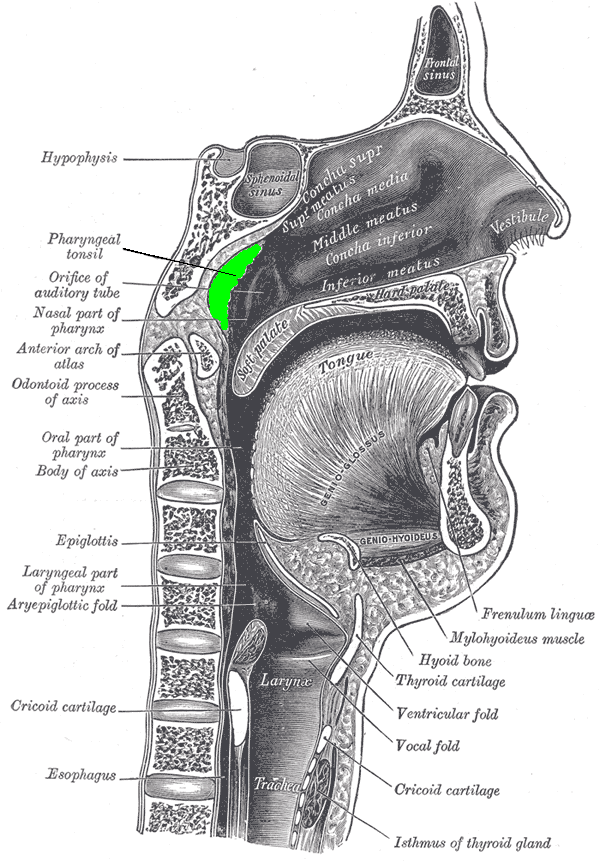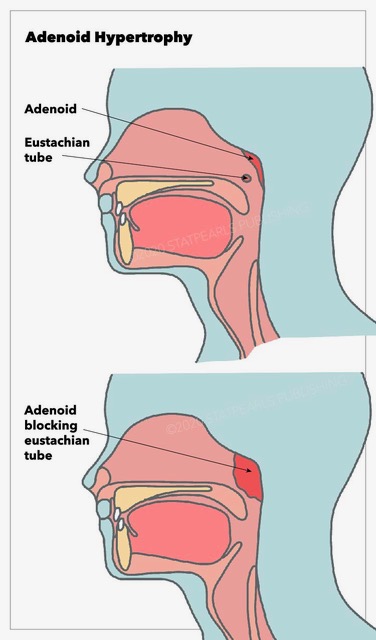[1]
Goeringer GC, Vidić B. The embryogenesis and anatomy of Waldeyer's ring. Otolaryngologic clinics of North America. 1987 May:20(2):207-17
[PubMed PMID: 3601384]
[2]
Tarasiuk A, Simon T, Tal A, Reuveni H. Adenotonsillectomy in children with obstructive sleep apnea syndrome reduces health care utilization. Pediatrics. 2004 Feb:113(2):351-6
[PubMed PMID: 14754948]
[3]
Proenca-Modena JL, Paula FE, Buzatto GP, Carenzi LR, Saturno TH, Prates MC, Silva ML, Delcaro LS, Valera FC, Tamashiro E, Anselmo-Lima WT, Arruda E. Hypertrophic adenoid is a major infection site of human bocavirus 1. Journal of clinical microbiology. 2014 Aug:52(8):3030-7. doi: 10.1128/JCM.00870-14. Epub 2014 Jun 11
[PubMed PMID: 24920770]
[4]
Brook I, Shah K. Bacteriology of adenoids and tonsils in children with recurrent adenotonsillitis. The Annals of otology, rhinology, and laryngology. 2001 Sep:110(9):844-8
[PubMed PMID: 11558761]
[5]
Swidsinski A, Göktas O, Bessler C, Loening-Baucke V, Hale LP, Andree H, Weizenegger M, Hölzl M, Scherer H, Lochs H. Spatial organisation of microbiota in quiescent adenoiditis and tonsillitis. Journal of clinical pathology. 2007 Mar:60(3):253-60
[PubMed PMID: 16698947]
[6]
Holm K, Bank S, Nielsen H, Kristensen LH, Prag J, Jensen A. The role of Fusobacterium necrophorum in pharyngotonsillitis - A review. Anaerobe. 2016 Dec:42():89-97. doi: 10.1016/j.anaerobe.2016.09.006. Epub 2016 Sep 28
[PubMed PMID: 27693542]
[7]
Brook I. The role of anaerobic bacteria in tonsillitis. International journal of pediatric otorhinolaryngology. 2005 Jan:69(1):9-19
[PubMed PMID: 15627441]
[8]
Ren J, Zhao Y, Ren X. [An association between adenoid hypertrophy and exstra-gastroesophageal reflux disease]. Lin chuang er bi yan hou tou jing wai ke za zhi = Journal of clinical otorhinolaryngology, head, and neck surgery. 2015 Aug:29(15):1406-8
[PubMed PMID: 26685418]
[9]
Evcimik MF, Dogru M, Cirik AA, Nepesov MI. Adenoid hypertrophy in children with allergic disease and influential factors. International journal of pediatric otorhinolaryngology. 2015 May:79(5):694-7. doi: 10.1016/j.ijporl.2015.02.017. Epub 2015 Feb 25
[PubMed PMID: 25758194]
[10]
France AJ, Kean DM, Douglas RH, Chiswick OM, St Clair D, Best JJ, Goodwin GM, Brettle RP. Adenoidal hypertrophy in HIV-infected patients. Lancet (London, England). 1988 Nov 5:2(8619):1076
[PubMed PMID: 2903300]
[11]
Rout MR, Mohanty D, Vijaylaxmi Y, Bobba K, Metta C. Adenoid Hypertrophy in Adults: A case Series. Indian journal of otolaryngology and head and neck surgery : official publication of the Association of Otolaryngologists of India. 2013 Jul:65(3):269-74. doi: 10.1007/s12070-012-0549-y. Epub 2012 Mar 29
[PubMed PMID: 24427580]
Level 2 (mid-level) evidence
[12]
Pereira L, Monyror J, Almeida FT, Almeida FR, Guerra E, Flores-Mir C, Pachêco-Pereira C. Prevalence of adenoid hypertrophy: A systematic review and meta-analysis. Sleep medicine reviews. 2018 Apr:38():101-112. doi: 10.1016/j.smrv.2017.06.001. Epub 2017 Jun 14
[PubMed PMID: 29153763]
Level 1 (high-level) evidence
[13]
Buzatto GP, Tamashiro E, Proenca-Modena JL, Saturno TH, Prates MC, Gagliardi TB, Carenzi LR, Massuda ET, Hyppolito MA, Valera FC, Arruda E, Anselmo-Lima WT. The pathogens profile in children with otitis media with effusion and adenoid hypertrophy. PloS one. 2017:12(2):e0171049. doi: 10.1371/journal.pone.0171049. Epub 2017 Feb 23
[PubMed PMID: 28231295]
[14]
Peltomäki T. The effect of mode of breathing on craniofacial growth--revisited. European journal of orthodontics. 2007 Oct:29(5):426-9
[PubMed PMID: 17804427]
[15]
Harari D, Redlich M, Miri S, Hamud T, Gross M. The effect of mouth breathing versus nasal breathing on dentofacial and craniofacial development in orthodontic patients. The Laryngoscope. 2010 Oct:120(10):2089-93. doi: 10.1002/lary.20991. Epub
[PubMed PMID: 20824738]
[16]
Feres MF, Hermann JS, Cappellette M Jr, Pignatari SS. Lateral X-ray view of the skull for the diagnosis of adenoid hypertrophy: a systematic review. International journal of pediatric otorhinolaryngology. 2011 Jan:75(1):1-11. doi: 10.1016/j.ijporl.2010.11.002. Epub 2010 Dec 3
[PubMed PMID: 21126775]
Level 1 (high-level) evidence
[17]
Ysunza A, Pamplona MC, Ortega JM, Prado H. Video fluoroscopy for evaluating adenoid hypertrophy in children. International journal of pediatric otorhinolaryngology. 2008 Aug:72(8):1159-65. doi: 10.1016/j.ijporl.2008.03.022. Epub 2008 May 13
[PubMed PMID: 18479759]
[18]
Lertsburapa K, Schroeder JW Jr, Sullivan C. Assessment of adenoid size: A comparison of lateral radiographic measurements, radiologist assessment, and nasal endoscopy. International journal of pediatric otorhinolaryngology. 2010 Nov:74(11):1281-5. doi: 10.1016/j.ijporl.2010.08.005. Epub 2010 Sep 15
[PubMed PMID: 20828838]
[19]
Parikh SR, Coronel M, Lee JJ, Brown SM. Validation of a new grading system for endoscopic examination of adenoid hypertrophy. Otolaryngology--head and neck surgery : official journal of American Academy of Otolaryngology-Head and Neck Surgery. 2006 Nov:135(5):684-7
[PubMed PMID: 17071294]
Level 1 (high-level) evidence
[20]
Chohan A, Lal A, Chohan K, Chakravarti A, Gomber S. Systematic review and meta-analysis of randomized controlled trials on the role of mometasone in adenoid hypertrophy in children. International journal of pediatric otorhinolaryngology. 2015 Oct:79(10):1599-608. doi: 10.1016/j.ijporl.2015.07.009. Epub 2015 Jul 13
[PubMed PMID: 26235732]
Level 1 (high-level) evidence
[21]
Demirhan H, Aksoy F, Ozturan O, Yildirim YS, Veyseller B. Medical treatment of adenoid hypertrophy with "fluticasone propionate nasal drops". International journal of pediatric otorhinolaryngology. 2010 Jul:74(7):773-6. doi: 10.1016/j.ijporl.2010.03.051. Epub 2010 Apr 28
[PubMed PMID: 20430451]
[22]
Kuhle S, Urschitz MS. Anti-inflammatory medications for obstructive sleep apnea in children. The Cochrane database of systematic reviews. 2011 Jan 19:(1):CD007074. doi: 10.1002/14651858.CD007074.pub2. Epub 2011 Jan 19
[PubMed PMID: 21249687]
Level 1 (high-level) evidence
[23]
Rosenfeld RM, Shin JJ, Schwartz SR, Coggins R, Gagnon L, Hackell JM, Hoelting D, Hunter LL, Kummer AW, Payne SC, Poe DS, Veling M, Vila PM, Walsh SA, Corrigan MD. Clinical Practice Guideline: Otitis Media with Effusion (Update). Otolaryngology--head and neck surgery : official journal of American Academy of Otolaryngology-Head and Neck Surgery. 2016 Feb:154(1 Suppl):S1-S41. doi: 10.1177/0194599815623467. Epub
[PubMed PMID: 26832942]
Level 1 (high-level) evidence
[24]
Baugh RF, Archer SM, Mitchell RB, Rosenfeld RM, Amin R, Burns JJ, Darrow DH, Giordano T, Litman RS, Li KK, Mannix ME, Schwartz RH, Setzen G, Wald ER, Wall E, Sandberg G, Patel MM, American Academy of Otolaryngology-Head and Neck Surgery Foundation. Clinical practice guideline: tonsillectomy in children. Otolaryngology--head and neck surgery : official journal of American Academy of Otolaryngology-Head and Neck Surgery. 2011 Jan:144(1 Suppl):S1-30. doi: 10.1177/0194599810389949. Epub
[PubMed PMID: 21493257]
Level 1 (high-level) evidence
[25]
Sjogren PP, Thomas AJ, Hunter BN, Butterfield J, Gale C, Meier JD. Comparison of pediatric adenoidectomy techniques. The Laryngoscope. 2018 Mar:128(3):745-749. doi: 10.1002/lary.26904. Epub 2017 Nov 20
[PubMed PMID: 29152748]
[26]
Ida JB, Worley NK, Amedee RG. Gold laser adenoidectomy: long-term safety and efficacy results. International journal of pediatric otorhinolaryngology. 2009 Jun:73(6):829-31. doi: 10.1016/j.ijporl.2009.02.020. Epub 2009 Mar 25
[PubMed PMID: 19324425]
[27]
Kuo CY, Lin YY, Chen HC, Shih CP, Wang CH. Video Nasoendoscopic-Assisted Transoral Adenoidectomy with the PEAK PlasmaBlade: A Preliminary Report of a Case Series. BioMed research international. 2017:2017():1536357. doi: 10.1155/2017/1536357. Epub 2017 Mar 28
[PubMed PMID: 28459055]
Level 2 (mid-level) evidence
[28]
Drago L, De Vecchi E, Torretta S, Mattina R, Marchisio P, Pignataro L. Biofilm formation by bacteria isolated from upper respiratory tract before and after adenotonsillectomy. APMIS : acta pathologica, microbiologica, et immunologica Scandinavica. 2012 May:120(5):410-6. doi: 10.1111/j.1600-0463.2011.02846.x. Epub 2011 Nov 25
[PubMed PMID: 22515296]
[29]
Bhattacharyya N, Lin HW. Changes and consistencies in the epidemiology of pediatric adenotonsillar surgery, 1996-2006. Otolaryngology--head and neck surgery : official journal of American Academy of Otolaryngology-Head and Neck Surgery. 2010 Nov:143(5):680-4. doi: 10.1016/j.otohns.2010.06.918. Epub
[PubMed PMID: 20974339]
[30]
Lehmann MD, Charron K, Kummer A, Keith RW. The effects of chronic middle ear effusion on speech and language development -- a descriptive study. International journal of pediatric otorhinolaryngology. 1979 Sep:1(2):137-44
[PubMed PMID: 553891]
[31]
Rosenfeld RM, Schwartz SR, Pynnonen MA, Tunkel DE, Hussey HM, Fichera JS, Grimes AM, Hackell JM, Harrison MF, Haskell H, Haynes DS, Kim TW, Lafreniere DC, LeBlanc K, Mackey WL, Netterville JL, Pipan ME, Raol NP, Schellhase KG. Clinical practice guideline: Tympanostomy tubes in children. Otolaryngology--head and neck surgery : official journal of American Academy of Otolaryngology-Head and Neck Surgery. 2013 Jul:149(1 Suppl):S1-35. doi: 10.1177/0194599813487302. Epub
[PubMed PMID: 23818543]
Level 1 (high-level) evidence
[32]
Huang YS, Guilleminault C. Pediatric Obstructive Sleep Apnea: Where Do We Stand? Advances in oto-rhino-laryngology. 2017:80():136-144. doi: 10.1159/000470885. Epub 2017 Jul 17
[PubMed PMID: 28738322]
Level 3 (low-level) evidence
[33]
Rotsides JM, Krakovsky GM, Pillai DK, Sehgal S, Collins ME, Noelke CE, Bauman NM. Is a Multidisciplinary Aerodigestive Clinic More Effective at Treating Recalcitrant Aerodigestive Complaints Than a Single Specialist? The Annals of otology, rhinology, and laryngology. 2017 Jul:126(7):537-543. doi: 10.1177/0003489417708579. Epub 2017 May 5
[PubMed PMID: 28474959]


